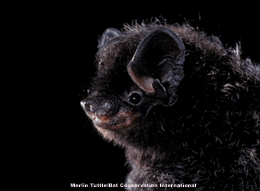Animal Fact Sheet: Silver-haired bat |
Identifying Features The silvered-haired bat (Lasionycteris noctivagans) is a medium-size bat. It's dark brown-black hairs are tipped with silver giving it an icy appearance. The silver-tipped hairs do not extend to the face or neck. Their ears are short, rounded and without fur. |
 |
Migration/Hibernation Silver-haired bats typically hibernate in small tree hollows, beneath sections of tree bark, in buildings, rock crevices, in wood piles, and on cliff faces. Occasionally they will hibernate in the entrances to caves, especially in northern regions of their range. |
Habitat Silver-haired bats are among the most common bats in forested areas of the United States. They are considered to be a solitary, tree-roosting species. |
Range Silver-haired bats are found throughout the United States (with Florida as an exception), northward into southern Canada. Their northern limit is in Alaska. They are also found southward into Mexico. |
Wild Status Silver-haired bats have no special endangered or threatened status at this time. Human activities such as logging, clear-cutting for development and roads, and general deforestation may pose a threat for the bat in the not too distant future. |
Diet Silver-haired bats are insectivorous. They are known to take flies, midges, leafhoppers, moths, mosquitoes, beetles, caddisflies, ants, crickets, and they have been observed consuming larvae on trees and occasionally spiders. Silver-haired bats mostly feed in mid-flight, but will occasionally go to the ground to obtain food. |
Predators Predators of silver-haired bats include skunks, owls, feral cats, and raccoons. |
Reproduction These bats form maternity colonies in tree cavities or small hollows. Mating takes place in early fall and fertilization is delayed until the following spring. Two pups are born between late June and early July. Just before birth takes place the female will begin to roost with her head facing upward. She will hold her tail membrane forward to form a cup-shaped basket which will catch the pups as they are born. |
Life Span It is estimated they can live up to12 years. |
Size Weight 0.25-0.45 oz (8 to 12 g) Wingspan 10-12 in (27-31 cm) |
Extra Fun-facts
|










